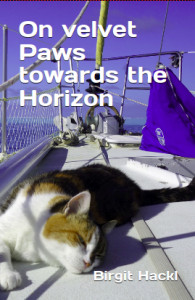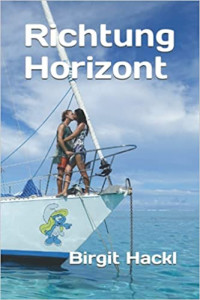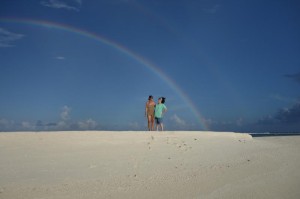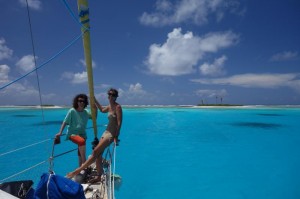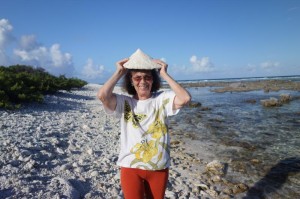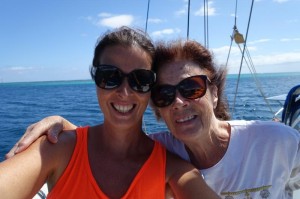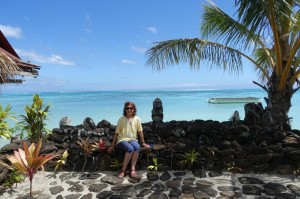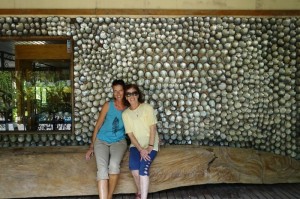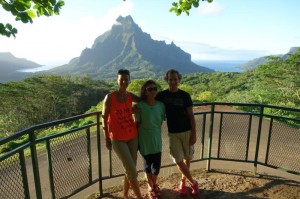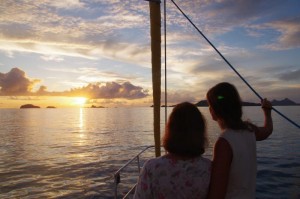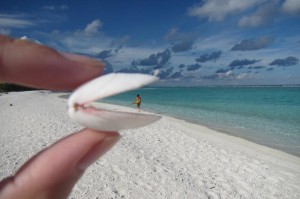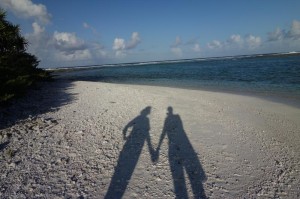After a comfy start we had a squally day yesterday and today we’re racing along in winds NE 16-20. 360 nm to go!
2020
30
Jan
2020
28
Jan
Raroia–nature worth protecting
Raroia impressed us with its wildlife–it’s among our top 5 atolls between French Polynesia and Tonga. We observed birds around the atoll, tried to estimate numbers and sent those to the ornithologist society SOP Manu in Tahiti. We also got in touch with the school principal and people from the mayor’s office and presented our pictures and findings. The general reaction was surprise and delight–locals don’t travel much and don’t know that it’s really special to still have motus with forest and bird colonies.
They promised to inform the population, make them aware of the treasure they have here and suggest how to help protecting it.
We hope those efforts will help the many sandpipers (endemic and endangered), masked/brown/redfooted boobies, sooty terns, crested terns, noddies (we even saw rare blue noddies), etc.
My mom still got the good news and was glad about it…
Now we’re on the way southeast towards the Gambier (maybe with a stop-over depending on the wind).
2020
26
Jan
My Mom
My Mom was always our biggest fan. I mainly wrote this blog for her, knowing that she’d turn on the laptop each morning, hoping for news or pics to have with her coffee. She was excited with us about wonderful experiences, disappointed and sometimes sad when we discovered harm done to nature. She fiercely defended our alternative lifestyle against whoever challenged her.
She visited us five times on the boat and we could share some of our favourite places on this beautiful planet with her.
My Mom died two days ago. I should have visited her more often, I could have phoned more often. I should and could have done so much and I would have–if only I had known that she’d leave us so soon.
2020
23
Jan
Article on Atoll Navigation in Cruising World
 Christian Feldbauer, Birgit Hackl: Navigating Paradise, Cruising World, January/February 2020, p. 89–92.
Christian Feldbauer, Birgit Hackl: Navigating Paradise, Cruising World, January/February 2020, p. 89–92.
Now also available as free online version on the CRUISING WORLD web page!
2020
22
Jan
When the supply ship comes…
Bigger atolls like Rangiroa, Fakarava or Makemo have medium-sized supermarkets by now that take credit cards and have supplies freshly flown in from Tahiti. Raroia is too small for that, so the arrival of the supply ship is a big day for the commune here. Today the ship arrived after a break of two months (they stopped their service during the holidays), so everybody rushes excitedly to the dock to get their parcels and stuff sent from Tahiti and the empty mini-market will be filled up again!
Unfortunately the village of Raroia is on the western side of the atoll, so we’ve been pitching badly in the waves from the easterly winds since we arrived here two days ago (that’s when the supply ship was actually due…) and we’re eager to get to the protected eastern side again.
The shop owner told us yesterday that he’d be busy unpacking all day today and would only start selling on Thursday, but we whinged until he promised to open the shop in the afternoon already–wish us luck for our quest for cabbage, carrots, potatoes and maybe even some apples ![]()
Our last egg from Makemo jumped into a chocolate cake yesterday and the last carrot from Tahiti joined some home-grown arrugula in a salad, so we can really use some fresh things…
2020
22
Jan
Birgit’s Interview with Jeanne Socrates
Jeanne passed through French Polynesia on her single-handed unassisted journey around the world. She checked in on our SSB net, the PolyMagNet and became the star of the net. She gave us an interview shortly before she finished her circumnavigation and became the oldest person to have accomplished this.
 Sam Jefferson, Birgit Hackl: Full Circle (Interview with Jeanne Socrates), Sailing Today January 2020, p. 58–60.
Sam Jefferson, Birgit Hackl: Full Circle (Interview with Jeanne Socrates), Sailing Today January 2020, p. 58–60.
2020
21
Jan
Article about the Cook Islands in Sailing Today Magazine
 Birgit Hackl, Christian Feldbauer: Too many Cooks (Our tour through the Cook Islands), Sailing Today January 2020, p. 34–38.
Birgit Hackl, Christian Feldbauer: Too many Cooks (Our tour through the Cook Islands), Sailing Today January 2020, p. 34–38.
2020
19
Jan
A Stove with Character
We still have an old-fashioned kerosene stove, called Bertie the Bertschi, which we praise when other cruisers search for gas bottles, refill opportunities and fittings while we have a year or two of kerosene on stock (after we raided a friendly little airport out on the islands…).
Unfortunately there are days when we curse it–today was one of them. Our main problem is that spare parts are no longer produced, so we try to squeeze everything out of the burners and other parts we have left. After it only produced a really small flame this morning, we cleaned the jet, but that only made the problem worse: suddenly we had a yellow flame spitting soot, then the burner got clogged, etc. After we had disassembled, cleaned and reassembled it for half a dozen times it suddenly worked again–not quite sure why, but we certainly won’t probe it while it lasts…
Afterwards we took Pitufa over to yet another gorgeous bird motu and enjoyed a wonderful two-hour snorkel playing with dozens of reef sharkies. Back home work was still lurking: while rummaging in the spare-part locker we had discovered a loose cable, so the rest of afternoon was spent squeezed under the table trying to solder and mend things…
Now we’re having a sundownwer and life’s good again (but the boat is still a mess with spare parts still all over the place)…
2020
14
Jan
All clear
All clear for those who were worrying about Leeloo’s health with us. She suddenly pulled herself together, started eating again and it looks like she’ll be with us for a bit longer ![]() Such ups and downs have been happening before…
Such ups and downs have been happening before…
Today we had a beautiful sail up NE close-hauled inside the lagoon staying close to the outer reef. Christian hopped into the dinghy with the camera while I stalled the boat, buzzed ahead to the next bommie and I sailed by as closely as possible–should be some nice pics! Afterwards we went for a snorkel in the shallows with the sharkies and now we’ve brewed a new batch of beer. No stress to leave this beautiful place.
2020
11
Jan
Cat worries
Leeloo’s health has been declining over the last years. She can still see, hear, jump (but not high, so we have put handicapped access to berths etc.), has all her teeth and on good days she’s out and about and munching (expensive, imported) diet food, but she also has bad days when she has no appetite and just sleeps a lot. She’s always been a fussy eater (even as a kitten) and now she simply has no appetite, but gets sick whenever she has an empty stomach–resulting in us running after her with little morsels every few hours (also at night).
For the last two days she has refused to eat and we’re worried for our little companion of almost twenty years…
2020
09
Jan
Nature paradise Raroia
We’re still hanging out in Raroia, where we’re the only boat ever since we arrived. We are enjoying nature while waiting for a window to the gambier. We keep busy with boat projects, some writing and use the good weather to visit the bird motus and marvel at the underwater world.
There are channels in the outer reef where clear ocean water flows in, resulting in great visibility and healthy coral. There it looks almost surreal–like something from a b movie or a disney land scenery: purple, yellow and green arty-farty sculptures and tons of reef sharkies in between. you round a corner in the half metre deep water and suddenly your snout-to-nose with one of them ![]()
We woke up two sleeping nurse sharks today and gave them a bit of a fright…
Apparently not many people come here, because there are still lots of snails and clams even in the shallows around.
On the way back we finally got lucky trolling with the dinghy and invited a bluefin jack for dinner ![]()
boat life at its best ![]()
2019
30
Dec
Almost in Raroia
We set out yesterday, despite a not-quite-ideal weather forecasts, but the forecasts tend to be wrong anyway and we just wanted to finally sail on. We spent the night tacking up and down, trying to dodge Taenga (atoll between Makemo and Raroia) in winds that were shifting between ENE and ESE. Now we’re finally approaching the pass of Raroia, lots of effort and 6 tacks for just 70 nm ![]()
2019
28
Dec
Christmas blow
Just for Christmas a trough moved along the convergence zone that had been lingering for a long time. It passed to the east of us, but sent us stormy weather with torrential rainfalls over Christmas, so we just stayed inside writing and working for 3 days. The anchorage just off the dock in Makemo was nicely protected, even though the wind shifted around a bit. The watertanks were full soon (we collect rainwater whenever we can, it saves working hours on the watermaker) and after that we filled up every container we could think of.
Today the sun was out again, so we did a big load of laundry, aired the cushions and mattresses–we don’t have any leaks on the boat, but after a few days with all hatches closed the whole boat felt damp. In the afternoon we went ashore for a walk–it really feels good to stretch the legs after a few days of commuting between the aft-cabin and the saloon sofa ![]()
2019
26
Dec
Makatea Gallery
Here our long overdue photos of Makatea!

Makatea
We visited Makatea, a raised atoll just a bit NE of Tahiti, in October 2019. There used to be phosphate mining, the overgrown relics look like an open-air museum. Ask for Ruben to get a tour of the island!
(24 photos)
2019
23
Dec
Merry Christmas and a Happy New Year!
And yet another year has passed–our 8th on Pitufa and we’re still very happy with our life under sails ![]()
We started the year 2019 quite active working on our mooring project in Rapa Iti and spent the rest of the cyclone season in our favourite corner of French Polynesia–the Gambier Islands. After that we had a few weeks of adventures in the Tuamotus, entering minimalistic, uncharted passes, exploring atolls–always searching for wildlife, getting disappointed in many places, but finding some untouched motus.
Then followed a prolongued time in Tahiti with my mom visiting, a serious shopping frenzy and a series of health issues: first Christian pinched off the tip of his index finger with our swimming ladder (surgery and a painful recovery took a while), then I managed to pick up a severe cold, a stomach bug and finally dengue fever.
After that we decided we had deserved some holidays away from it all, so we’ve been hanging out in the Tuamotus for a while, enjoying our usual mixture of boat projects, writing and nature exploring ![]() Leeloo is getting a bit frail and tired, but is still doing well given her age.
Leeloo is getting a bit frail and tired, but is still doing well given her age.
We wish all those who sail along on our blog a merry Christmas and a happy, healthy, successful and interesting year 2020!


